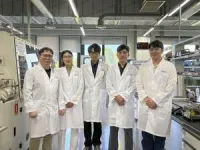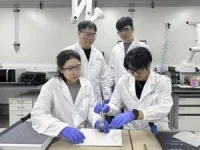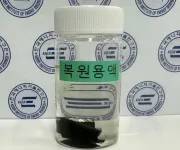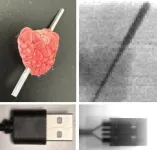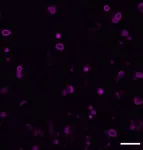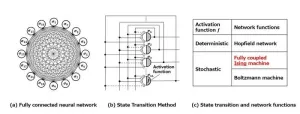(Press-News.org) CLEVELAND—Researchers at Case Western Reserve University have identified a new target to treat atherosclerosis, a condition where plaque clogs arteries and causes major cardiac issues, including stroke and heart attack.
In a new study, published in the journal Cell Reports, they identified an inflammation-reducing molecule—called itaconate (ITA)—that could be the foundation of a new approach to treat such a common and deadly disease.
Heart disease is the leading cause of death for men, women and people of most racial and ethnic groups, according to the U.S. Centers for Disease Control and Prevention.
Medications help but don’t completely protect patients from cardiovascular risk. So, doctors also recommend lifestyle changes, such as a low-cholesterol/low-fat diet (LCLFD), to further reduce plaque and inflammation that increase the risk of cardiovascular disease. Yet many patients find it challenging to follow diet restrictions long-term.
Identifying the role ITA plays in diet and heart disease may help address this.
“We’ve found that itaconate is crucial to the diet’s ability to stabilize plaques and reduce inflammation, which has been a mystery until now,” said Andrei Maiseyeu, associate professor at the Cardiovascular Research Institute and Department of Biomedical Engineering at Case Western Reserve’s School of Medicine. “This discovery marks a major leap forward in the understanding of how diet-induced plaque resolution occurs at a molecular level.”
Based on their discovery, Maiseyeu and his team have developed a new treatment: ITA-conjugated lipid nanoparticles (ITA-LNP, U.S. Provisional Application No. 63/707,954). This new therapeutic approach allows ITA to accumulate in plaque and bone marrow, where it reduces inflammation and mimics the beneficial effects of LCLFD without requiring drastic lifestyle changes.
“We have already seen its effectiveness in multiple models of atherosclerosis,” Maiseyeu said. “We are optimistic that this will result in better treatments that will greatly lower the long-term risk of heart attacks and strokes while also improving patients’ quality of life.”
Maiseyeu and his team are now taking steps to translate ITA-LNP to the clinic, including engineering a pill form of the treatment, which they believe will not only be convenient for patients, but also transformative.
###
At Case Western Reserve, one of the nation's leading research universities, we're driven to seek knowledge and find solutions to some of the world's most pressing problems. Nearly 6,200 undergraduate and 6,100 graduate students from across 96 countries study in our more than 250 degree programs across arts, dental medicine, engineering, law, management, medicine, nursing, science and social work. Our location in Cleveland, Ohio—a hub of cultural, business and healthcare activity—gives students unparalleled access to engaging academic, research, clinical, entrepreneurial and volunteer opportunities and prepares them to join our network of 125,000+ alumni making an impact worldwide. Visit case.edu to learn more.
END
A research team led by Dr. Jung-Je Woo at the Gwangju Clean Energy Research Center of the Korea Institute of Energy Research (KIER) has successfully developed a cost-effective and eco-friendly technology for recycling cathode materials* from spent lithium-ion batteries.
*Cathode Materials: Materials that play a crucial role in generating electricity by storing and releasing lithium ions during battery charging and discharging.
With the recent rise in electric vehicles and mobile devices, managing spent batteries has become a critical global challenge. By 2040, the number of decommissioned electric vehicles is expected to exceed 40 million*, leading ...
Most people don’t enjoy getting shots for treatments or vaccines. So, researchers are working to create more medicines, such as those made from messenger RNA (mRNA), that can be sprayed and inhaled. A study in the Journal of the American Chemical Society reports steps toward making inhalable mRNA medicines a possibility. Researchers outline their improved lipid-polymer nanoparticle for holding mRNA that is stable when nebulized and successfully delivers aerosols (liquid droplets) in mice’s lungs.
mRNA ...
X-rays are a common component of diagnostic testing and industrial monitoring, used for everything from monitoring your teeth to scanning your suitcase at the airport. But the high-energy rays also produce ionizing radiation, which can be dangerous after prolonged or excessive exposures. Now, researchers publishing in ACS Central Science have taken a step toward safer X-rays by creating a highly sensitive and foldable detector that produces good quality images with smaller dosages of the rays.
“This advancement reduces detection limits and paves the way for safer and more energy-efficient medical imaging and industrial monitoring,” says Omar F. Mohammed, ...
Few questions have captivated humankind more than the origin of life on Earth. How did the first living cells come to exist? How did these early protocells develop the structural membranes necessary for cells to thrive and assemble into complex organisms?
New research from the lab of University of California San Diego Professor of Chemistry and Biochemistry Neal Devaraj has uncovered a plausible explanation involving the reaction between two simple molecules. This work appears in Nature Chemistry.
Life on Earth ...
PLYMOUTH MEETING, PA [November 13, 2024] — The National Comprehensive Cancer Network® (NCCN®)—an alliance of leading cancer centers—today announced the publication of a new patient guideline designed to provide critical support and guidance for individuals with cancer who are seeking to quit smoking. Continued smoking elevates the risk of developing additional cancers, reduces the effectiveness of treatment, exacerbates treatment side effects, and is associated with shorter survival. The new NCCN Guidelines for Patients®: Quitting Smoking explains how to best use the tools that exist to help anyone quit ...
Computers are essential for solving complex problems in fields, like scheduling, logistics, and route planning, but traditional computers struggle with large-scale combinatorial optimization, as they can’t efficiently process vast numbers of possibilities. To address this, researchers have explored specialized systems.
One such system is the Hopfield network, a significant artificial intelligence breakthrough from 1982, proven in 1985 to solve combinatorial optimization by representing solutions as energy levels and naturally finding the lowest energy, or optimal, solution. ...
About The Study: This randomized clinical trial demonstrates that cognitive behavioral therapy for prolonged grief was superior to present-centered therapy after treatment and at follow-up with regard to comorbid symptoms. Both treatments were shown to be effective and acceptable, showing the potential for dissemination and increasing patient choice.
Corresponding Author: To contact the corresponding author, Rita Rosner, PhD, email rita.rosner@ku.de.
To access the embargoed study: Visit our For The Media website ...
Sometimes plants are so similar to each other that the methods developed by 18th century scientist Carl Linnaeus for identifying species are not enough. In a thesis from the University of Gothenburg, completely new species of daisies have been discovered when analysed using modern DNA technology.
There are currently estimated to be around 8.7 million different species on Earth, of which around 2.2 million are found in the oceans. Many species can be identified in the classical way, by their physical characteristics, the morphology. For over a decade, botanists and zoologists have also been using DNA sequencing to more accurately identify species. ...
INFORMATION EMBARGOED UNTIL WEDNESDAY, NOV. 13, 2024, 7 a.m. ET
C-Path Announces Gender Equitable Medicines for Parkinson's Disease (GEM-PD) Initiative
C-Path expands its worldwide leadership in accelerating drug development in neurology; seeks additional collaborators to broaden impact.
TUCSON, Ariz., November 13, 2024 — Critical Path Institute (C-Path) today announced a landmark initiative, Gender Equitable Medicines for Parkinson's Disease (GEM-PD), dedicated to globally ...
Glaciers that are within three miles of a volcano move nearly 50% quicker than average, a new study has found, which could help create early warning of future eruptions.
In a new article published in Communications Earth & Environment today, researchers from the University of Aberdeen, University of Birmingham and Manchester Metropolitan University analysed velocity data from 85% of the world’s approximately 217,000 glaciers. After controlling for factors such as climate, ice thickness and surface slope, the team found that glaciers near active volcanoes typically flowed 46% faster than other glaciers.
Glaciers ...

